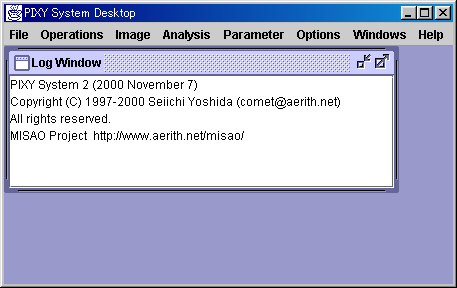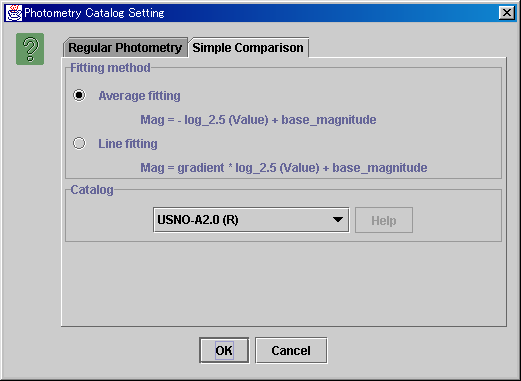Photometry
- The contents of "Guideline of photometry" are the summary of
instructions by Taichi Kato and Seiichiro Kiyota in the VSOLJ(Variable
Star Observers' League in Japan) mailing list.
|
This page introduces how to determine the magnitude of a star properly
based on the image examined by the PIXY System 2.
 Guideline of photometry
Guideline of photometry
Depends on the filters, CCD chips and the reference catalogs, there
three types of photometry.
(1) Standard system
When you observe a star using some standard filter, such as V, B, Rc,
etc., you have to use catalogs which contains the magnitude in
standard system, the same system as the filter you use, as reference.
For example, when you observe a star using a standard V filter, you
have to refer to a catalog which contains standard V magnitude (Tycho
Catalogue, for instance).
When the standard V magnitude of a star is recorded in the catalog as
10.0 mag, the magnitude of another star which is 2.5 times brighter
than it will be 9.0 mag.
In principle, standard filters are specific to the CCD chips.
You have to use the proper filter for your CCD chip.
Instead, the magnitude in the standard system measured as mentioned
above is consistent with other observers' data in the same system.
Sometimes the magnitude in some standard system are not recorded in
the catalog.
Then you can convert from magnitude in other standard systems.
For example, when you observe a star using the standard Rc filter,
there is no Rc data in the Tycho Catalogue.
Then you can convert from V magnitude and B-V value recorded in the
catalog into the approximate Rc magnitude following the formula:
Rc = V - 0.5 * (B-V)
and determine the magnitude using this approximate Rc magnitude.
When you observe a star using the standard Ic filter, you can convert
from B magnitude and B-V value into the approximate Ic magnitude
following the formula:
Ic = B - 2.36 * (B-V)
Natali F., Natali G., Pompei E., Pedichini F., 1994, A&A 289, 756
The use of the (B-I) color index and applications of the (B-I) versus (B-V) relationship
(2) Non-standard system
In case of unfiltered CCD images, or images using non-standard filters
(IR-blocking filters, for instance), you have to estimate the feature
of your own system at first, then convert from the standard magnitude
recorded in the catalog into the specified magnitude for your own
system.
In general, the feature of a system is resembled by the following
linear equation of standard V magnitude and B-V value:
Instrumental mag = V + k * (B-V)
For some typical CCD chips such as KAF, TC-241, etc., the coefficient
of (B-V) is obtained in Arne A. Henden's research:
Henden, A. A., "The M67 Unfiltered Photometry Experiment",
2000, Journal AAVSO vol. 29, page 35.
ftp://ftp.nofs.navy.mil/pub/outgoing/aah/m67/paper/
When you observe a star using other CCD chips, or using non-standard
filters, you have to calculate the formula for your own system based
on the images at first.
When the formula is obtained, you can convert from the standard V
magnitude and B-V value in some catalog (Tycho Catalogue for instance)
into the magnitude specified for your own system by the formula, then
determine the magnitude based on the converted magnitude.
For example, the standard magnitude of a star are recorded in the
catalog as:
V mag = 10.0 mag
B-V = 0.8 mag
If the image is an unfiltered CCD image of KAF chip, the feature of
your own system is:
Instrumental mag = V - 0.5174 * (B-V)
by Henden's research. So the magnitude of this star specified for your
system will be:
Instrumental mag = 10.0 - 0.5174 * 0.8
= 10.0 - 0.41392
= 9.6
The magnitude of another star which is 2.5 times brighter than it will
be 8.6 mag.
The magnitude measured as mentioned above is specified for your CCD
chip and filter.
It is consistent with other observers' data using the same type of CCD
chip and filter.
However it is not consistent with other observers' data using
difference type of CCD chip or filter.
(3) Simple magnitude comparison
When the feature of your CCD chip and filter is uncertain, or there
are no stars in the image field whose standard magnitude are recorded
in the catalog, it is impossible to determine the magnitude in the
regular style.
Especially in case of narrow images, only such catalogs as the GSC or
the USNO-A2.0 may be available to refer the magnitude.
In those cases, only you can do is to determine the magnitude of a
star simply comparing to the magnitude recorded in the catalogs.
For example, the magnitude of a star is recorded in the USNO-A2.0
catalog as:
R mag = 10.0 mag
B mag = 14.0 mag
Then the magnitude of another star which is 2.5 times brighter than it
will be: 9.0 mag using the R magnitude, or 13.0 mag using the B
magnitude.
The magnitude measured as mentioned above can have a large shift from
the true value.
Because the base point is not fixed, the magnitude of a star measured
from several images shows large scatter.
For example, the magnitude of a star can be 10.0 mag in one image, and
11.0 mag in another image.
(A) Appendix
The (B-V) value of the base star of photometry is 0.0 mag.
When there is a star whose (B-V) value is 0.0 mag in the image field, you can determine the true magnitude of any other stars comparing to the brightness of the star, whatever filters you use.
In this case, you do not have to obtain the formula for your own system.
However, there are some sorts of stars which cannot be used for photometry even if the (B-V) value is 0.0 mag.
So it is not recommended that you determine the magnitude of stars comparing to only one star in the image field, even if the (B-V) value of the star is 0.0 mag.
 Photometry using the PIXY System 2
Photometry using the PIXY System 2
You have to examine the image as introduced in the Examine Your Image page and save the result in
the XML file in advance.
Next you have to identify with the catalog used in photometry as
introduced in the Look Up Comets, Asteroids,
Variable Stars, Clusters and Nebulae in the Image Field page.
For example, if you examine the image using the USNO-A2.0, but would
like to determine the magnitude using the Tycho Catalogue considering
the feature of your own system, you have to identify with the Tycho
Catalogue in advance.
After identification, save the result in the XML file.
When the catalog used in the examination is also used in the
photometry, identification can be passed.
After identification, star data used in photometry are recorded in the
XML file. Then let's start the photometry.
First of all, run the PIXY System 2 and select Review in
the main menu window.

Then a new virtual desktop appears.

First, open the XML file.
Select the [File] - [Open XML File] menu and open the XML
file of the examination result.
Then select the [Analysis] - [Photometry] menu, and a dialog
appears to set up the photometry operation.
As introduced in the Guideline of Photometry,
there are three types of photometry.
When you would like to determine the magnitude in regular style as
mentioned in the Standard system or Non-standard system
sections, select the Regular Photometry tab.
When you would like to determine the magnitude by simple magnitude
comparison as mentioned in the Simple magnitude comparison
section, select the Simple Comparison tab.
Selecting the Regular Photometry tab, the following window
appears.

In case of the image taken using the standard filter, check the
Standard system and select one filter.
In case of the unfiltered CCD images, look up the combo box. If your
CCD chip is in the list, check the Unfiltered CCD image and
select the CCD chip.
In case your CCD chip is not in the list, or you use non-standard
filters, check the Other instruments.
When the feature formula of your system is already obtained, input the
coefficient of B-V value.
Otherwise, check the Calculate system formula, then the
system calculates the feature formula for your system based on the
current image, and determines the magnitude using the calculated
formula.
Finally, select a reference catalog.
Selecting the Simple Comparison tab, the following window
appears.

When you check the Average fitting, the system determines the
magnitude so that the average of the difference between measured
magnitude and catalog magnitude becomes 0.
When you check the Line fitting, the system calculates the
linear equation between logarithm of the measured pixel count value
and catalog magnitude, then determines the magnitude using the
calculated equation.
In general, check the Average fitting.
Finally, select a reference catalog.
After the setting is finished, push the OK button.
Then a table appears which shows the magnitude and other data in the
catalog, measured magnitude and residuals.
On top of the table, the number of data used in photometry, the error
of photometry, the equation to convert the pixel count value into
magnitude, are output.
When you check the Calculate system formula, the feature
formula of your own system calculated based on the current image is
also output.

Zoom In
Selecting the data using the check box in the table, the measured
magnitude and the equations output on top of the table are updated.
In general, it is recommended to click the Residual column,
sort the data in order of residual, and reject illegal data with large
residual.

|
In this example, one data with large residual is rejected.
The Position value implies that the brightness of this star
is wrong because it is at edge.
The formula of this example system is calculated as:
Instrumental mag = V - 0.6679 * (B-V)
|
Finally, push the Apply button and the magnitude of all
detected stars are determined.
After photometry finished, save the result in the XML file.
After that, click a star on the Detected Stars chart, and
you can see the measured magnitude.

Zoom In
| 






